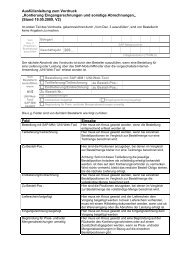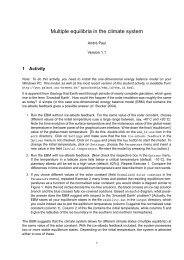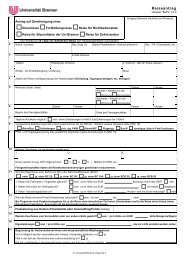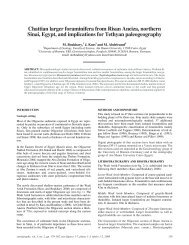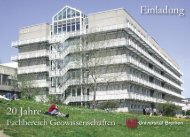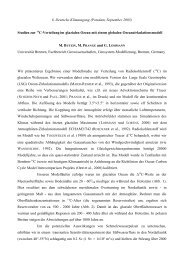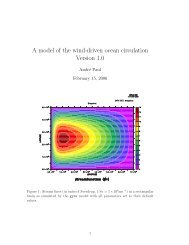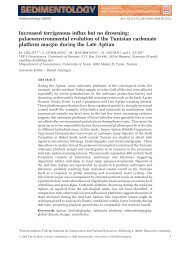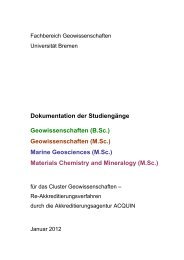- Seite 1: Norddeutscher Verbund für Hoch- un
- Seite 8 und 9: viGeowissenschaften 41Planetenentwi
- Seite 13: 1EinleitungDer Norddeutsche Verbund
- Seite 18 und 19: 6Hüpfende Protonen als Brücke zwi
- Seite 20 und 21: 8Theory can explain and design mate
- Seite 22 und 23: 10Die geheimnisvollen Bewegungen de
- Seite 24 und 25: 12Pack den Wasserstoff in den TankQ
- Seite 26: 14Oberflächen von Nanokristalliten
- Seite 31 und 32: 19Figure 1: Reaction mechanisms for
- Seite 33 und 34: 21Figure 1: Local structures for Au
- Seite 35 und 36: 23Figure 1: Top: The interactions b
- Seite 37 und 38: 25Abbildung 1: Modell einer Ceroxid
- Seite 39 und 40: 27A. B.C.HWDPBDHWDPBDHWDHSDHSDHSDPB
- Seite 41 und 42: 29(a) (b) (c)86 π ∗420K-2 K´-4k
- Seite 43 und 44: 31Figure 1: Model for a subnanomete
- Seite 45 und 46: 33LYS−GLUDipeptid(1) (2)(1)(2)H1H
- Seite 47 und 48: 35Figure 1: Structure of the icosah
- Seite 49 und 50: 37Abbildung 1: Links: Querschnitt d
- Seite 51 und 52: 39Abbildung 1: Links: Schematische
- Seite 53 und 54: 41GeowissenschaftenGeowissenschafte
- Seite 55 und 56: 43Bei einer Verzehnfachung des CO 2
- Seite 57 und 58: 45Abbildung 1: Zonalgemittelte Temp
- Seite 59 und 60: 47Abbildung 1: Temperaturdifferenz
- Seite 61 und 62: 49Abbildung 1: Änderungen von Temp
- Seite 63 und 64: 51Abbildung 1: Wasserdampf [molec/c
- Seite 65 und 66: 53Figure 1: Four snapshots of botto
- Seite 67 und 68: 55Abbildung 1: Effekt der Hebung vo
- Seite 69 und 70: 57Abbildung 1: Rechengitter und Max
- Seite 71 und 72: 59Abbildung 1: Tropische Niederschl
- Seite 73 und 74: 61Abbildung 1: Idealisierte Modells
- Seite 75 und 76: 63Abbildung 1: Mittlere Änderung d
- Seite 77 und 78:
65Abbildung 1: Dargestellt ist der
- Seite 79 und 80:
6725004006010Abbildung 1: Modellgeb
- Seite 81 und 82:
6910.5555 ° N0.955 ° N0.50.4554
- Seite 83 und 84:
71Abbildung 1: Mittlere Strömungsb
- Seite 85 und 86:
73Abbildung 1: Das Modellgitter der
- Seite 87 und 88:
75Abbildung 1: Strömungsbedingunge
- Seite 89 und 90:
77Abbildung 1: Stromlinien in einer
- Seite 91 und 92:
79Abbildung 1: Sicht von oben auf e
- Seite 94 und 95:
82Turbulenz in der Wettervorhersage
- Seite 96 und 97:
84Kann das Schmelzen des Grönlande
- Seite 98 und 99:
86Wann, woher und wohin? - Untersuc
- Seite 100 und 101:
88Wie gut sind unsere Beschreibunge
- Seite 102 und 103:
90Geht den tropischen Ozeanen die L
- Seite 104 und 105:
92Legt die globale Erwärmung eine
- Seite 106 und 107:
94Geowissenschaften
- Seite 108 und 109:
96Dompteur der StrömungNumerische
- Seite 110 und 111:
98Numerische Optimierung strömungs
- Seite 112 und 113:
100Kontrollierte Verdichtung in Flu
- Seite 114 und 115:
102Does a sponge reduce jet screech
- Seite 116 und 117:
104Das Flugzeug muss leiser werdenU
- Seite 118 und 119:
106Turbulence simulations for green
- Seite 120 und 121:
108Das Triebwerk muss leiser werden
- Seite 122 und 123:
110Eingefrorene StrömungenNumerisc
- Seite 124 und 125:
112Strömungssimulationen zur Lärm
- Seite 126 und 127:
114Rotierende Lärmquelle hinter Gi
- Seite 128 und 129:
116Ecolonomically Improved Road Veh
- Seite 130 und 131:
118Hai-Schuppen verbessern, um Ener
- Seite 132 und 133:
120A matter of disorderOxidized sil
- Seite 134 und 135:
122Design neuer Metalloxyd-Halbleit
- Seite 136 und 137:
124Rise and Roll3D Modeling of Hydr
- Seite 138 und 139:
126Turbulenzen beim Wärmeaustausch
- Seite 140 und 141:
128RollexBestimmung der Rolldämpfu
- Seite 142 und 143:
130ShipLES - Berechnung der instati
- Seite 144 und 145:
132Wärmeübergang auf Dellenoberfl
- Seite 146 und 147:
134Simulation von turbulenten Misch
- Seite 148 und 149:
136Luftwirbel im FlugantriebSimulat
- Seite 150 und 151:
138Zustandsbeurteilung eines Triebw
- Seite 152 und 153:
140Die Wandlung von Energie ist ein
- Seite 154 und 155:
142Fortschrittliche Simulation turb
- Seite 156 und 157:
144Energieeffiziente Aggregate für
- Seite 158 und 159:
146Design of Leading and Trailing E
- Seite 160 und 161:
148Ablösungen aufgelöst - Einblic
- Seite 162 und 163:
150Numerisches StörfeuerNumerische
- Seite 164 und 165:
152Systemspezifische Turbolader-Sch
- Seite 166 und 167:
154Tail plane aerodynamics of aircr
- Seite 168 und 169:
156Ingenieurwissenschaften
- Seite 170 und 171:
158Der Infrarotlimes der Quantenchr
- Seite 172 und 173:
160The Higgs bosonDetermination of
- Seite 174 und 175:
162Der Quark-Gluon-Phasenübergang
- Seite 176 und 177:
164Fundamental Constants of Quantum
- Seite 178 und 179:
166The beauty of particle physicsB-
- Seite 180 und 181:
168Habitabilität von Super-Erden:
- Seite 182 und 183:
170Nanostructures for biosensing de
- Seite 184 und 185:
172Heisser TanzVerschmelzung von Ne
- Seite 186 und 187:
174Cosmic Magnetic FieldsMagnetic f
- Seite 188 und 189:
176Wie sehen Sterne und extrasolare
- Seite 190 und 191:
178Von exotischer Quantenphysik zur
- Seite 192 und 193:
180Ab Initio Solution of QCD, the F
- Seite 194 und 195:
182Wie die Abstoßung zwischen Elek
- Seite 196 und 197:
184Wasser unter hohem Druck - einfa
- Seite 198 und 199:
186Kleine Teilchen in großer Aufre
- Seite 200 und 201:
188First-Principles Approaches to t
- Seite 202 und 203:
190Was passiert hinter dem Mond?Num
- Seite 204 und 205:
192Eine Reise mit vielen Fragezeich
- Seite 206 und 207:
194Wie Turbulenz in Galaxienhaufen
- Seite 208 und 209:
196Vielteilchentanz im Gigahertz-Ta
- Seite 210 und 211:
198Elektronen im Atom in Aufregung
- Seite 212 und 213:
200Chirale Nanomagnete an Oberfläc
- Seite 214 und 215:
202Erforschung der räumlichen Orga
- Seite 216 und 217:
204Physik
- Seite 218 und 219:
206Kurze Wege in großen SystemenMR
- Seite 220 und 221:
208Schnell und energiesparend - Neu
- Seite 222 und 223:
210Pushing the frontier of solvabil
- Seite 224 und 225:
212DatenassimilationHochskalierende
- Seite 226 und 227:
214FESOM - Großskalige Ozeanmodell
- Seite 228 und 229:
216Virtuelle 3D-Welten - Ergebnisse
- Seite 230 und 231:
218Methodenentwicklung
- Seite 232 und 233:
220Organisationsstruktur des HLRNDe
- Seite 234 und 235:
222ICE1 XE ICE2 UVProzessor, Intel
- Seite 236:
224Abbildung 5: 7.200 Glasfaserkabe



